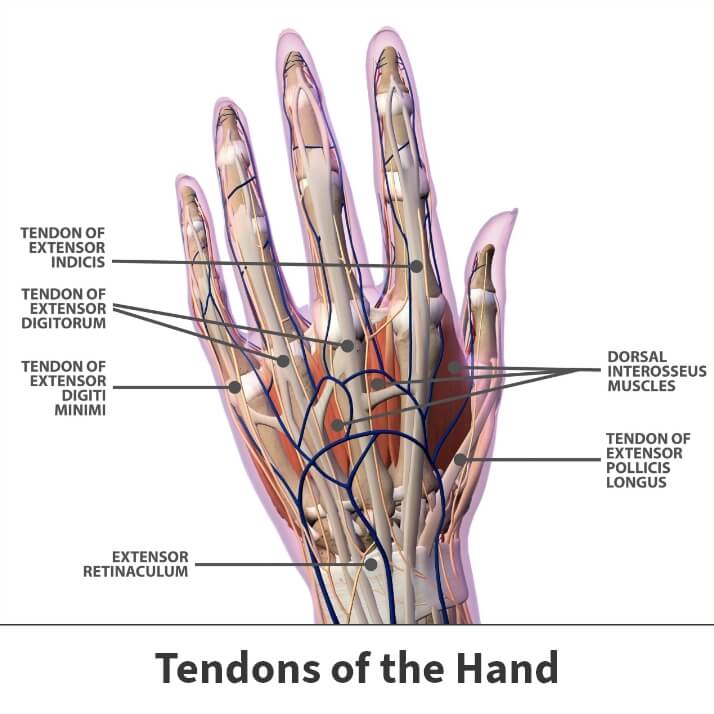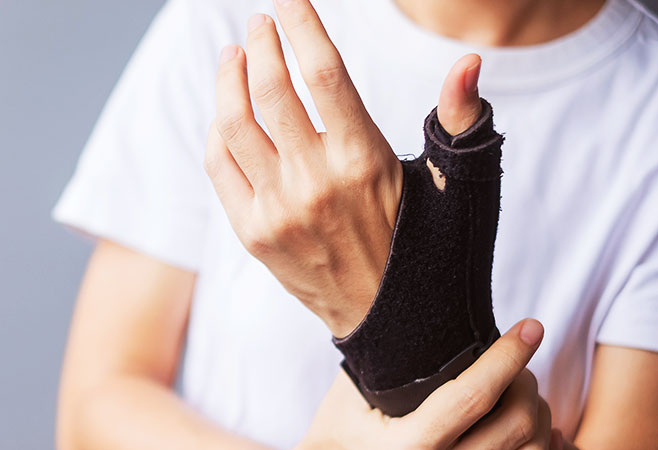Anatomy

The wrist is made up of numerous tiny bones and soft tissues, such as tendons. De Quervain’s tenosynovitis impacts the two tendons.
About
Swollen tendons produce inflammation in the sheaths, which are the protective coverings surrounding soft tissues. Sheath inflammation places significant pressure on surrounding nerves, which causes the numerous unfortunate physical signs associated with the condition.
Causes
Medical researchers have been unable to identify a specific cause of de Quervain’s tenosynovitis. Chronic overuse of the wrists could be a significant factor since tendons attach muscle to bone and are used in the smooth and fluid movement of the hand and wrist.
People who consistently grip, grasp, or pinch are at higher risk by placing increased pressure on the wrist tendons. Additionally, traumatic wrist injuries or inflammation-inducing diseases, like arthritis, are thought to be potential triggering causes.
Orthopedic specialists also think that the following risk factors might increase the chance of developing de Quervain’s tenosynovitis:
- Gender – Women are more likely to develop this condition
- Age – De Quervain’s tenosynovitis typically strikes people between the ages of 30 and 50
- Lifestyle – Persons with professions or hobbies necessitating frequent or awkward wrist movements may be at increased risk
- Pregnancy – Expecting women are more likely to develop the problem
Parents of babies and young children are also considered a high-risk category since they often lift their children frequently and unintentionally use their thumbs for leverage and balance. These repeated motions place undue strain on thumb tendons that may lead to de Quervain’s tenosynovitis.
Symptoms
The most common physical indication is pain. Discomfort from de Quervain’s tenosynovitis typically appears as a moderate to severe ache at the thumb’s bottom. The pain is often described as a sticking sensation that comes and goes. However, the discomfort is most severe when they move their thumb or perform some type of gripping or grasping movement. Other symptoms include swelling around the thumb’s base and difficulty with doing basic wrist movements.
De Quervain’s tenosynovitis is a progressive ailment, meaning that failure to address it early can lead to further complications. A lack of medical treatment could cause serious problems, such as pain extending into the thumb, the entire wrist, and even the forearm.
Diagnosis
Your Florida Orthopaedic Institute physician will begin the examination of your hand by testing to see if you feel pain or pressure when executing simple wrist, hand, and thumb movements.
Your physician may also perform the Finkelstein Test. In this test, the patient bends their thumb over their palm, bending the remainder of their fingers downward atop the thumb and bending their wrist towards their little finger. If this causes pain in the wrist’s thumb side, the diagnosis will likely be confirmed.
X-ray are often taken during evaluation, however, more advanced imaging or tests are not usually required.
Treatment
The specific treatment employed depends upon several different factors, including:
- The patient’s age
- Their general health
- If the condition can be traced back to any underlying medical problem
- The severity of the inflammation or existing structural damage
Other factors that might play into designating specific treatment include a patient’s lifestyle (example: if they are the parents of babies or young children), and their level of physical activity.
Nonsurgical treatment options
In mild cases, over-the-counter non-steroidal inflammation-reducing or pain-alleviating medications are recommended, such as Advil/Motrin (ibuprofen) and Aleve (naproxen). However, if swelling is severe, steroid injections made directly into impacted tendon sheaths are a treatment option.
Other nonsurgical options include:
- Immobilizing the impacted thumb or wrist inside a sling or other movement-restraining device
- Restricting thumb or wrist movements as much as possible
- Performing a variety of exercises geared towards strengthening and improving the wrist and thumb’s mobility
- Applying ice
Some individuals benefit from occupational therapy. A professional known as an occupational therapist reviews how the patient moves their wrist and thumb when performing routine activities and offer suggestions on how their actions can be made with greater efficiency.
Learn More About Occupational Therapy
Surgical treatment options
In more serious cases, surgery may be indicated. Surgical intervention typically involves the opening of the sheaths to alleviate pressure on the tendons. Following surgery, physical therapy may be recommended to help the patient recapture strength and mobility in their wrist and thumb.

Videos
Related specialties
- Basal Joint Surgery
- Carpal Tunnel Syndrome
- Dislocated Finger
- Distal Radius Fracture (Broken Wrist)
- Dupuytren’s Disease
- Flexor Tendonitis
- Fractured Fingers
- Functional Nerve Transfers of the Hand
- Ganglion Cysts
- Hand & Finger Replantation
- Hand Nerve Decompression
- Hand Skin Grafts
- Nerve Pain
- Peripheral Nerve Surgery (Hand) Revision
- Revascularization of the Hand
- Rheumatoid Arthritis of the Hand
- Sports Wrist & Hand Injuries
- Sprained Wrist
- Sudden Acute Finger, Hand & Wrist Injuries
- Targeted Muscle Reinnervation (TMR)
- Tendon Transfers of the Hand
- Thumb Ulnar Collateral Ligament Injuries
- Trigger Finger
- Ulnar Neuritis
- WALANT (Wide Awake Local Anesthesia No Tourniquet)
- Wrist Arthroscopy
- Wrist Fractures
- Wrist Tendonitis
